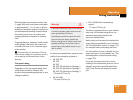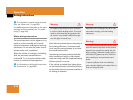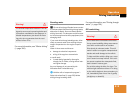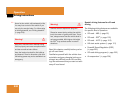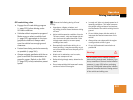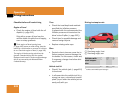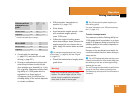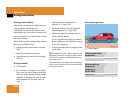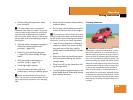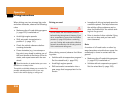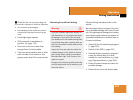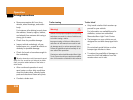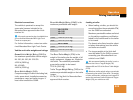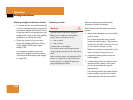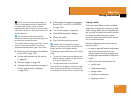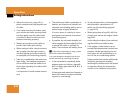
325
Operation
Driving instructions
ț Before driving through water, deter-
mine its depth.
ț Vehicles with air suspension program*:
Select the highest vehicle level
possible (
୴ page 255).
ț Switch to off-road driving program
(
୴ page 253) before driving through
water.
ț Shift automatic transmission to
position 1 or 2 (
୴ page 192).
ț Avoid high engine speeds.
ț Enter and leave the water only at a
shallow spot, driving at walking speed.
ț Drive through the water slowly and at a
constant speed.
ț Do not stop vehicle while immersed in
water, and do not shut off the engine.
ț There is a very high level of driving re-
sistance in water. The surface is slip-
pery and may not be firm, making
pulling away in water difficult and dan-
gerous.
ț Make sure that only small bow waves
are formed when driving the vehicle
through water.
ț Clean mud off the tire tread after driv-
ing through water.
ț To dry the brakes, apply pressure to the
brake pedal several times while driving
after leaving the water.
Crossing obstacles
!
The water depth must not exceed the
respective value listed in the table. The ground
under the water might not be firm which could
result the water being deeper than expected
when driving the vehicle through it. Please note
that the water level is correspondingly lower for
flowing water.
!
Never accelerate before driving into the
water. The bow wave could force water into the
engine and auxiliary equipment, thus damaging
them.
!
Do not open any of the vehicle’s doors while
driving through water. Water could otherwise en-
ter the vehicle interior and damage the vehicle’s
electronics, as well as the interior equipment.
!
Obstacles can damage the vehicle
underbody or suspension components. If possi-
ble use the assistance of a second person out-
side the vehicle to scout the path you intend to
take and check for adequate ground clearance
when you cross obstacles with your vehicle. The
person assisting you outside the vehicle should
always be a safe distance away from the vehicle
and positioned so that he or she cannot get hurt
in case of any unexpected vehicle movement.
After off-road driving or crossing obstacles, in-
spect vehicle for any damage, especially vehicle
underbody and suspension components. Failure
to do so can adversely affect the vehicle’s future
performance, including increased chance of an
accident.



